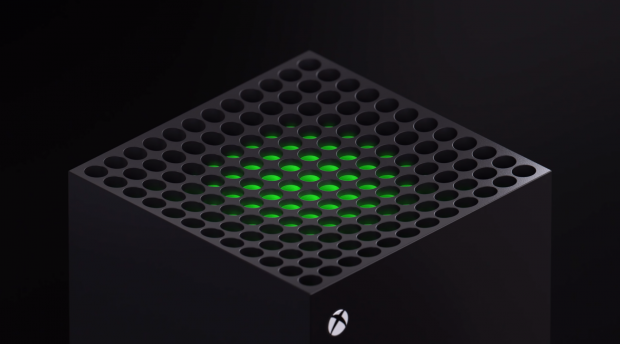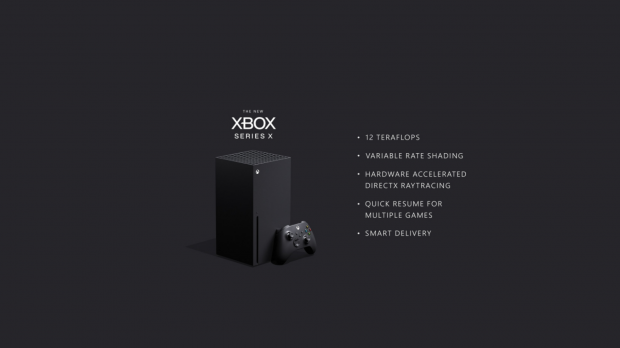As consoles get more and more advanced, it's important that developers have access to more powerful software development tools to squeeze out every last drop of hardware might. No one knows that better than Microsoft.

Microsoft is going above and beyond with the Xbox Series X. Not only will the system have a huge 12TFLOP RDNA 2-powered Navi GPU that enables new effects like ray tracing, 8K resolution, and 120FPS gaming, but the next-gen Xbox also comes packed with massively optimized SDK dev tools for crafting new experiences. Flexible and fast software environments are just as important as hardware, and the Xbox Series X's true potential lies in the synergy between the two.
In a recent Major Nelson podcast, Xbox exec Jason Ronald reiterated just how important software is.
"Teraflops are an easy to gauge the power of the GPU. But in reality we view power much more expansively beyond just TFLOPs. We put a lot of innovation into the Xbox Series X and the real magic is going to be the integration between hardware and software to not only use the raw capabilities of the box, but also to use it in the most efficient way possible to make your games even better," said Jason Ronald, partner director of program management at Xbox.
"Our approach is really about how developers can best use all the power that we're delivering to them in the hardware. There's a lot of new capabilities in the Xbox Series X that developers have never been able to do before."

In the podcast, Ronald touched upon new features like Direct X accelerated raytracing, which adds a new dimension to visuals via lighting effects, reflections, weather and fog effects, and can even be used for spatial audio.
Other transformative Xbox Series X dev features include Variable Rate Shading (VRS) which allows devs to decrease resolution in certain parts of a scene to boost frame rates.
Variable Rate Shading will combine with Variable Refresh Rates, which syncs the console's video output to a display's refresh rate, and Automatic Low-Latency Mode, which automatically adjusts gameplay to the lowest possible ms latency of a display, to deliver up to 120 frames-per-second gaming.
The opportunities are absolutely huge for developers and we'll see creativity foster like never before as teams experiment with the system's hardware and software.
"Our expectations for Gen 9 with the Xbox Series X is everything from new level of power we're delivering, which is unlike anything we've ever seen before, as well as pairing that with innovative speed and that we're really making sure we're getting the player to the fun as quickly as possible," Ronald said.
The Xbox ecosystem is already tremendously flexible. With the Xbox SDK, devs can make one game and scale it automatically to Xbox consoles, Windows 10 PCs, or even mobile devices--and now the Xbox Series X sees a big evolution of that focus. Developers now have a huge arsenal of tools and dynamic features to pick and choose how to best optimize their game, whether it be an online-driven live game where frame rates matter most, or a slower, more cinematic experience where 4K visuals and effects are prioritized.

If that wasn't enough, devs will also have the choice in how they upgrade current-gen games to play on the next-gen Xbox.
Microsoft recently confirmed that the Xbox Series X will play four generations' worth of Xbox games. "If it plays on Xbox One, it'll play on Xbox Series X," Microsoft said on Twitter.
It also confirmed that every game will natively play better on the Xbox Series X via a built-in automatic boost mode. This can raise everything from frame rates and resolution while reducing screen tearing.
Developers can choose to just leave their games be and enjoy backwards compatibility, or they can upgrade them with enhancement patches, similar to how the Xbox One X Enhanced upgrades work. Developers will have the option to roll out new updates that allow existing games to pull from the Xbox Series X's extra power.
The potential here is huge. Devs could breathe new life into older games with higher frame rates, ray tracing lighting and visuals, 4K assets, and maybe even baking in upscaled 8K support to boot.
Thus armed, developers have tons of different ways to not only boost their upcoming games, but also revitalize older catalog titles on the Xbox Series X.
Xbox Series X is due out by Holiday 2020. No pricing has been announced.
Check below for confirmed specs and details, and a huge content listing of everything we've heard about Xbox Series X so far:
Xbox Series X confirmed details (Formerly Project Scarlett):
- 8-core, 16-thread Zen 2 CPU
- 12 TFLOP Navi GPU on RDNA 2 architecture
- Highly customized 7nm SoC from AMD
- GDDR6 memory
- 2x Xbox One X's 6TFLOPs of GPU perf
- 4x CPU power of Xbox One generation
- Can deliver up to 40x more performance than Xbox One in specific use cases
- Adaptive sync supported
- Super-fast SSD that can be used as VRAM
- Supports 8K resolution (likely media playback)
- 120FPS gaming
- Variable refresh rate (adaptive sync/FreeSync)
- Variable Rate Shading
- Raytracing confirmed with dedicated raytracing cores
- Backward compatible with thousands of Xbox, Xbox 360, and Xbox One games
- New controller with a dedicated share button
- Compatible with Xbox One accessories
Lockhart (Unconfirmed lower-end Xbox Series hardware)
- 1440p 60FPS
- No disc drive
- Super-fast SSD that can be used as VRAM
- 7nm AMD SoC w/ scaled-down 8-core, 16 thread Zen 2 CPU at 3.5GHZ and Navi GPU
- Lower GDDR6 memory pool (Possibly 12GB)
- ~6-8 TFLOPs of power?
- Aims to rival PS4 Pro/Replace Xbox One S
- Full backward compatibility with all Xbox One games
- Cheaper MSRP
Anaconda/Xbox Series X/Project Scarlett
- 4K 60FPS
- Disc drive with 4K UHD playback
- Super-fast SSD that can be used as VRAM
- 7nm AMD SoC with 8-core, 16 thread Zen 2 CPU at 3.5GHz and Navi GPU
- 16GB GDDR6 RAM
- 12 TFLOPs of power
- 2x GPU power as Xbox One X/aims to replace Xbox One X
- Full backward compatibility with all Xbox One games
- More expensive MSRP
Xbox Series X coverage:
- Xbox Series X natively plays all Xbox games better
- Xbox Series X 12 TFLOP GPU confirmed, 4x Xbox One CPU and 8x GPU power
- Xbox Series X packs dedicated audio hardware acceleration
- How publishers will approach current-gen on PS5, Xbox Series X
- Xbox Series X and PlayStation 5 pricing expected to be $500
- Xbox studio using AI to upscale low-res textures in real-time
- Coronavirus may delay PlayStation 5, Xbox Series X launch past 2020
- Xbox Series X may support CFExpress memory cards
- Xbox Series X might support UltraWide monitors thanks to Samsung
- Xbox Series X CPU is the key to next-gen frame rates, Spencer teases
- China trade tariffs won't directly raise PS5, Xbox Series X prices
- AMD unknown APU: is this the mid-range Xbox Series S chip?
- Xbox Series X SSD: DRAM-less PCIe 4.0 NVMe with up to 3.7GB/sec speeds
- First photo of an Xbox Series X prototype has leaked
- Next-gen console exclusives will be few and far between through 2021
- No, Xbox Series X won't run Steam or the Epic Store
- Ex-Xbox VP won't buy next-gen Xbox, will play exclusives on PC instead
- Xbox Series X HDMI pass-through currently not supported
- New Xbox Series X renders show ventilation and back ports
- Xbox Series X new die shot teases beautiful AMD custom 7nm APU
- Analyst: $500 Xbox Series X will take wind out of Microsoft's sails
- PlayStation 5 to outsell Xbox Series X in 2020, analyst predicts
- Xbox Lockhart going digital-only at launch would be a mistake
- Xbox Series X new die shot teases beautiful AMD custom 7nm APU
- Xbox Series X will destroy PlayStation 5 with its MUCH faster GPU
- Xbox Series X rumor: launching November 22 for $499
- Xbox Series X GPU is better than any Navi GPU released so far
- Xbox Series X may be more powerful, but will third-party devs use it?
- Xbox Series X will boost performance of previous gen Xbox games
- PS5, Xbox Series X SSD may use software-defined flash to boost speeds
- Microsoft to 'virtually eliminate' loading times on Xbox Series X
- How the Xbox Series X will look in your living room
- Clarifying the Xbox Series X name
- Xbox Series X's custom SoC built with backward compatibility in mind
- Next-gen Forza is playable on Xbox Series X, is 'vastly different'
- Xbox Series X size comparison vs Xbox One, PS4 Pro, Switch
- Next-gen Xbox controller has a share button
- Xbox Series X naming scheme leaves door open for Lockhart
- Xbox Series X may allow suspend and resume for multiple games at once
- Microsoft reveals next-gen Xbox console, the Xbox Series X
- Xbox Series X may allow suspend and resume for multiple games at once
- Next-gen Xbox Lockhart has 'significantly less RAM' for 1440p gaming
- Next-gen Xbox Scarlett specs: 12TFLOPs, 16GB RAM, 3.5GHz Zen 2 CPU
- Cheaper next-gen Xbox Lockhart targets 1440p 60FPS
- Cheaper next-gen Xbox Lockhart targets 1440p 60FPS
- Project Scarlett devkits aren't widely available yet
- PS5, Xbox Scarlett SSD may use Optane-like ReRAM to supercharge speeds
- NVIDIA G-Sync monitors to improve PlayStation 5 and Xbox Scarlett
- Project Scarlett won't get VR gaming, Microsoft doesn't care about VR
- Next-gen Xbox Scarlett plays four generations of Xbox games
- Microsoft teases next-gen Xbox: 8K, 120FPS, super-fast SSD
- Xbox Scarlett CPU: 'no compromises', allows for 4K 120FPS gaming
- Microsoft: Xbox Scarlett will kick PlayStation 5's ass in perf/price
- Next-gen Xbox may hit 4K 60FPS in every game
- Project Scarlett to hit 1080p 120FPS gaming
- Project Scarlett trade-in program announced, but there's a big catch
- New Viking Assassin's Creed may be next-gen console launch game
- Next-gen Xbox may get room-scale VR gaming
- PS5 and Xbox Scarlett will both handle ray tracing differently
- Gears 5 developer says Xbox Scarlett has dedicated ray tracing cores
- GTA 6 on PS5, Project Scarlett to have insane hyper-realistic visuals
- AMD 'Flute': Xbox Scarlett SoC: Zen 2 8C/16T @ 3.2GHz on 7nm
- Project Scarlett's price isn't locked in yet
- Project Scarlett isn't the last Xbox console

